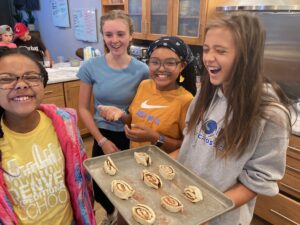Eric Sheninger’s Disruptive Thinking in our Classrooms: Preparing Learners for Their Future

“If we are to develop students who think disruptively, we must examine and reflect on our current teaching and learning practices. We, too, must become disruptive thinkers, which I define as: replacing conventional ideas with innovative solutions to authentic problems.”
Eric Sheninger’s latest title, “Disruptive Thinking in our Classrooms: Preparing Learners for Their Future” is a book for the moment. He has pulled together universal wisdom from across our field as well as his own work coaching education leaders following the paradigm shift that affected our practice unlike anything before. Sheninger offers guidance for reestablishing familiar pedagogical theories for emerging from disruption in order to best serve learners as teachers, administrators, engaged family members, and others that support our schools and personnel.
As other sectors embrace remote work going forward, students and their families will continue to want more flexibility in learning models from our schools as well. Sheninger wants to ensure we’re not throwing the baby out by the bathwater as in-person learning returns in some form as vaccinations prevail and restrictions are lifted. He encourages us to stay true to the time-tested insights from the pioneers of modern K-12 education in the present, marrying the possibilities that we’re suddenly all afforded by the digital tools that have enhanced in record time to extend the reach of teachers who were engaged in learning from home.
He organizes the book into three parts:
- Re-Thinking Normal
- Re-Thinking Learning
- Re-Thinking the Learner
The chapters in each of the book’s sections are consistent in providing high-, mid-, and low-level entry points for education professionals to revisit time-tested ideas through the lens of all that galvanized us during the peak of learning during the pandemic, no matter whether it was in-person and socially-distanced, learning from home–both synchronously, and asynchronously, or in some hybrid fashion where learners were engaging with instruction both in and out of their familiar learning environments.
Sheninger hopes to redirect our energies to empower the same sorts of gains for students as we move forward after such a disruption as what began in the Spring of 2020. “The future of work requires new skills, and it is up to the K-12 education sector to lead the charge in this area. Skills are not enough, in my opinion. Yes, we want learners to possess the requisite knowledge and skills to meet the needs and demands required of them.” (p.19)
In the opening chapters, he sets the stage with a high-elevation expectation we share as educators, that, “…it is our duty and the role of education to ensure they are confident, competent, and contributing members of society. Above all else, our learners must be able to think and learn differently” (p.19). Blending the right amount of philosophy with pragmatic advice, Sheninger encourages practitioners to reconcile what they believe with what they practice: “…lifelong learning is a must for all of us, not just the kids we serve. For our students to meet the demands and expectations for work now and in the future, we must commit to professional growth now and in the future.” (p.20)
If this vision resonates for the reader, how do we get there? The chapters in the next two sections of the book offer ample opportunities for edleaders to choose low-hanging fruit based on their current state as it aligns with the unique vision they have for their learners. Acknowledging the shrewd resource budgeting that he had to monitor and manage, Sheninger encourages some corporate self-care to extend beyond what many surfaced in the pandemic as essential: “We must make the time to learn and grow as opposed to finding the time. If we rely on the latter, chances are it will never happen.” (p.20)
As idyllic as it seems to incorporate such measures with already scarce bandwidth, this is something that can be carried forward. He goes on to say, “The time is now to move the needle on transformational change in education. The longer we wait, the greater the risk to those we serve-–our kids—and to our future society.” (p.20)
For all the ways we want to improve the field, our propensity for acquiescing to the gravitational pull of yesteryear will be too compelling when ESSER funding diminishes and we enjoy being in the same room with our learners once again in the first grading period of the new school year. We need to resist those forces when we’re weary and put in place interventions that keep us from resorting to regression during the next inevitable disruption. “If we continue down the track of sustaining outdated practices in education, we will continue to churn out a population of students who may be good at ‘doing school,’ but may not be prepared to do well in life. This applies not only to K-12 but also higher education.” (p.20)
A long-held but challenging belief is that learning today and beyond must be as personalized for each and every student as possible. Sheninger thinks last year proved we’re able to do that now as long as we have cultivated talent to use the right techniques equipped with appropriate technology. “A renewed focus on creating schools that work for kids through uncommon learning strategies that are not being implemented in schools at scale can help to transform numerous facets of traditional schooling (Sheninger, 2015). Transforming learning is a momentous task that must be driven by unearthing the why across all facets of school culture.” (p.71) It’s certainly a complex undertaking, but feasible as the means are there and he discusses the first steps in considerable detail, with ample supports in the book’s Resources appendix.
Now, we’re in an era of our profession where it would be helpful to share the belief that we balance our technology with more adept techniques as practitioners in learning development. Sheninger says, “Pedagogy trumps technology. It also goes without saying that a solid pedagogical foundation should be in place prior to implementing any ‘innovation’.” (p.85) He goes on, saying, “What is certain is that the future workforce will need to align its mindset and skillset to keep pace with evolving demands. The lesson learned is as simple as it is profound: Don’t prepare learners for something. Prepare them for anything.” (p.81)
He shares his conviction that educators need to change their approach given that “All kids doing the same thing, the same way, at the same time just doesn’t cut it anymore. As a result, there is a need for a shift to a more personal approach to learning.” (p.125). He draws a clear throughline to prior efforts to differentiate learning for students. This means creating more avenues for children of all ages and backgrounds to have agency in their learning pathways.
The book illuminates how authentic relationships between administrators and teachers as well as teachers and students anchor the shift to a more personalized learning model in our schools:
“To fully prepare all learners for their future, we must create classrooms in which disruptive thinking is a major component of the learning process. Disruptive thinking in the classroom will only become a reality, however, when priceless relationships are in place. With these in place, your impact will be felt for generations as the learners you influence today disrupt the bold new world in ways that change it—and us—for the better.” (p.163)
Like the excellent teacher and administrator he was in the first part of his career, Sheninger continues to use his skills to reinforce our own skill development in education leadership by making it practical and applicable.
What I appreciate most from Sheninger is that he’s making the old new again. Instead of clearing the decks from before the pandemic, he’s shining a new light on the proven ideas and those that provided them in the first place. Through the capacity building we all did during the shutdown, it’s important to not reinvent the wheel. We knew things before we’d always wanted to implement. We knew practices in how we orchestrate teaching and learning, design instructional activities and even in how we assess and offer learners feedback have been ripe for the sort of change we experienced last year.
For education leaders looking for a solid professional learning guide that is comprehensive in breadth and depth with so many practical ideas backed up by research, this book would galvanize your team by recalibrating what we know works and making it feasible given the investments happening in our districts right now from federal funding. The book is a fast-paced and inspiring read for any working in and for our schools, looking for a means to elevate their practice with disruptive thinking as we get back to planning to make ’21-’22 the best school year ever.
“Never underestimate your vital role in impacting the life of a child. Students might not realize it now, but later in life many will thank you in their own way for your belief in and commitment to them.” (p.163)
For more, see:
- Mark White and Dwight Carter on Leading Schools in Disruptive Times
- Personalized Learning Is Special Education and the Time Is Now
Stay in-the-know with innovations in learning by signing up for the weekly Smart Update.






0 Comments
Leave a Comment
Your email address will not be published. All fields are required.